Whether you’re a seasoned hiker or a newbie to exploring nature, national parks provide a diverse range of landscapes and experiences for all. From leisurely strolls through scenic vistas to intense treks up rugged mountains, it’s a choose-your-own-adventure experience. Some may prefer the serene beauty of pristine forests, while others may be drawn to the allure of exotic islands with sandy beaches and vibrant marine wildlife. Regardless of the destination or activity, one thing remains essential: prioritizing safety for yourself, others, and the environment.
That’s why it’s important to heed warnings, follow guidelines, and abide by park rules. This includes choosing the right clothing and gear for maximum safety and comfort. Proper attire can make your experience much easier and enjoyable, while the wrong choices can lead to discomfort or even pose safety risks. From avoiding uncomfortable materials to inappropriate footwear, make sure you know what not to wear when visiting national parks.
Cotton
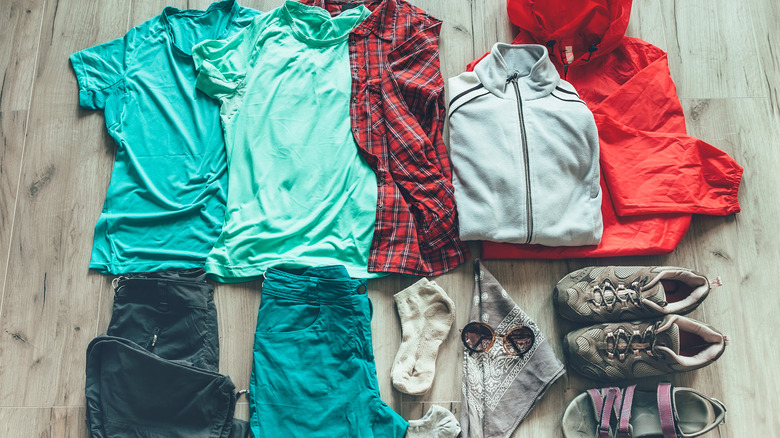
Cotton might seem comfy, but it’s a no-go for outdoor adventures in national parks. “Cotton kills,” as they say in the hiking community. Cotton absorbs moisture and takes hours to dry, which can be a real problem if you get caught in the rain or sweat heavily during a hike. Wet cotton can also lead to chafing and discomfort. In colder temperatures, it can even cause disorientation and hypothermia.
Instead, go for moisture-wicking fabrics like polyester, nylon, or even wool if you need a warmer material. These fabrics will help keep you dry and comfortable by wicking moisture away from your skin and drying quickly. Plus, they’re often more durable and better suited for hiking and exploring.
Denim
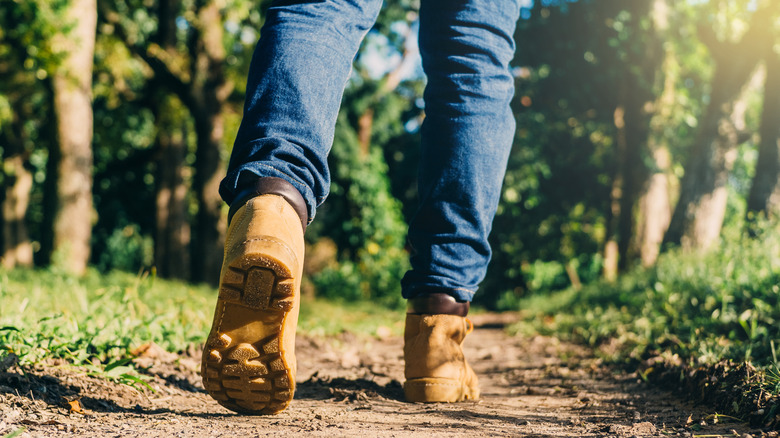
Jeans might be a staple in your wardrobe, but they’re not the best choice for a day out in the national park. Technically, denim is made from cotton, so they share some of the same properties that make them unsuitable for outdoor adventures. Jeans are heavy, restrictive, and take forever to dry if they get wet.
Despite being famously stylish, a pair of jeans also offers little to no insulation when wet, which can be dangerous in colder environments. Instead, consider wearing lightweight and quick-drying hiking pants or shorts made of nylon and polyester blend to stay comfortable and agile on the trails.
Too-tight clothes
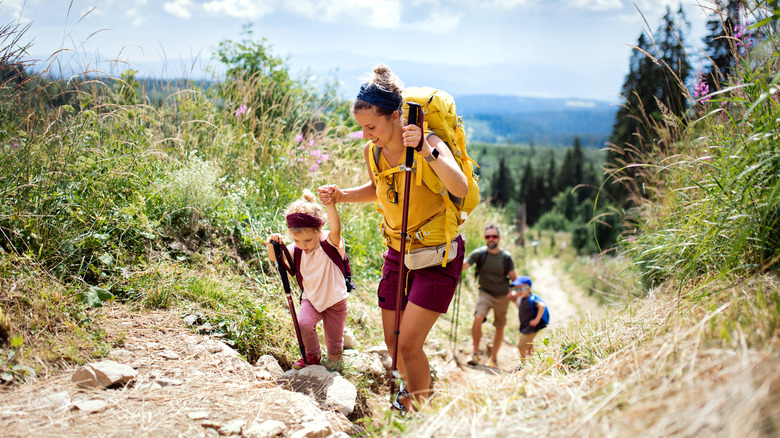
Ground Picture/Shutterstock
Wearing clothes that are too tight can restrict your range of motion, making it difficult to navigate rough terrain or climb obstacles, which can be dangerous when exploring national parks. Tight clothing can also cause chafing in areas where the fabric rubs against the skin, leading to irritation and blisters.
In a more extreme spectrum, tight clothes can restrict blood flow, which can be particularly taxing during long hikes or strenuous activities.
Too-loose clothes

Oleh_slobodeniuk/Getty Images
While tight clothes can be restrictive, wearing clothes that are too loose also has its disadvantages. Loose clothing can get caught on branches, rocks, or other obstacles, increasing the risk of accidents and injuries. Additionally, loose clothing can be uncomfortable, as it may constantly shift and require readjustment.
In colder weather, loose clothing may not provide sufficient insulation, leading to discomfort or even hypothermia. In conclusion, it’s best to wear clothing that fits well and allows for a full range of motion without being too tight or too loose. For bottoms, you can look for pants with features like adjustable or elastic waistbands that can help you achieve a comfortable fit while exploring the outdoors.
Skirts and dresses
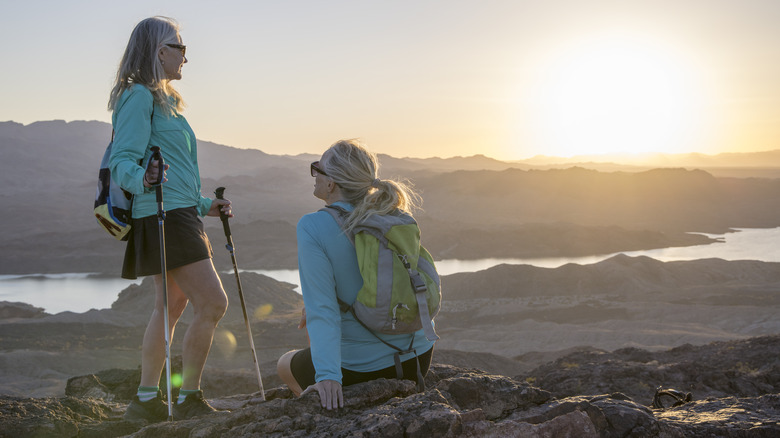
Ascentxmedia/Getty Images
It may seem obvious that skirts and dresses are not the most practical choice for a day of exploring the outdoors. They offer no protection underneath and may restrict your movement in navigating uneven terrains. They can also be tricky in windy weather and carry a risk of being caught in branches.
However, if you’re set on wearing them, there are ways to make them work. Pair them with comfortable, moisture-wicking leggings or shorts underneath for added coverage and protection. You can also opt for a skort and choose lightweight, quick-drying materials.
Non-breathable jackets
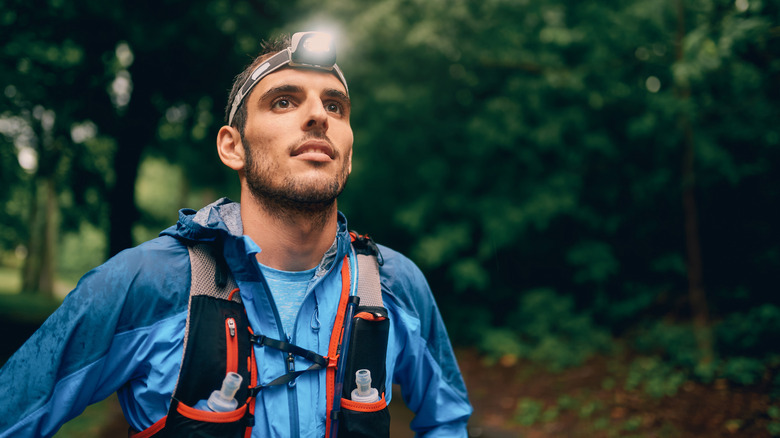
AYA images/Shutterstock
Different weather conditions call for different types of jackets, but one thing they should all have in common is breathability. A breathable material allows you to wick sweat away from your base layer instead of trapping moisture inside. Even your rain jacket needs to be breathable otherwise you’ll still get damp from sweat on the inside.
Use materials like Gore-Tex for water resistance and breathability, or look for jackets with zippers under the armpit or other ventilation features that can help regulate moisture and body temperature.
Flip-flops
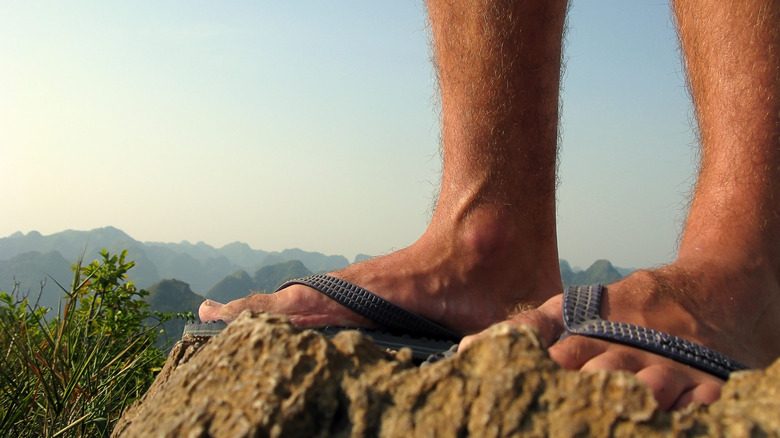
JourneyToTheMind/Shutterstock
Keep your flip-flops for a fun day at the beach, as they’re not suitable for walking and exploring around the national park. These flimsy sandals offer little to no protection for your feet, leaving them vulnerable to cuts, scrapes, and insect bites.
Moreover, flip-flops provide minimal support and traction, making them unsuitable for slippery or muddy trails. Their thin, flexible soles provide little grip, increasing the likelihood of slipping or losing your footing, particularly on steep or rocky terrain. Even if you’re walking on established trails, flip-flops can cause irritation between the toes when worn for a long walk.
Slides
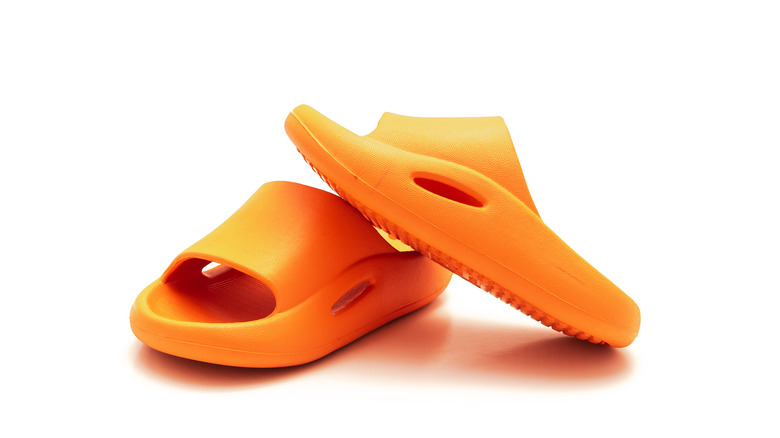
Trong Nguyen/Shutterstock
Just like flip-flops, slides provide insufficient traction, making them too slippery for an outdoor adventure. Unlike hiking boots or trail shoes, they also lack cushioning, which is important for padding and absorbing impact. This lack of cushioning can lead to discomfort and foot fatigue, especially during long hikes on hard surfaces.
Slides also do not have ankle support, which exposes you to the danger of twisting or spraining your ankle, particularly on rocky or unstable surfaces.
High heels
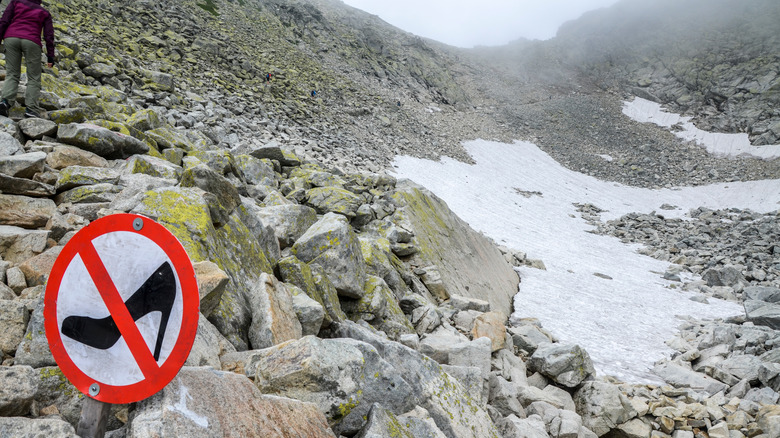
Dmytro Stoliarenko/Shutterstock
Some might think it’s obvious, but you’ll be surprised that there are people who have attempted climbing and hiking in high heels on a regular basis. However sweet and elegant, a pair of high heels simply doesn’t offer many of the basic things needed for proper footwear on an outdoor adventure.
One of the main disadvantages of high heels is their lack of stability. The narrow base and elevated heel make them prone to slipping and twisting on uneven or rocky terrain, increasing the risk of ankle sprains or falls. Additionally, the unnatural position of the foot can lead to muscle fatigue, cramping, and even blisters.
Canvas shoes
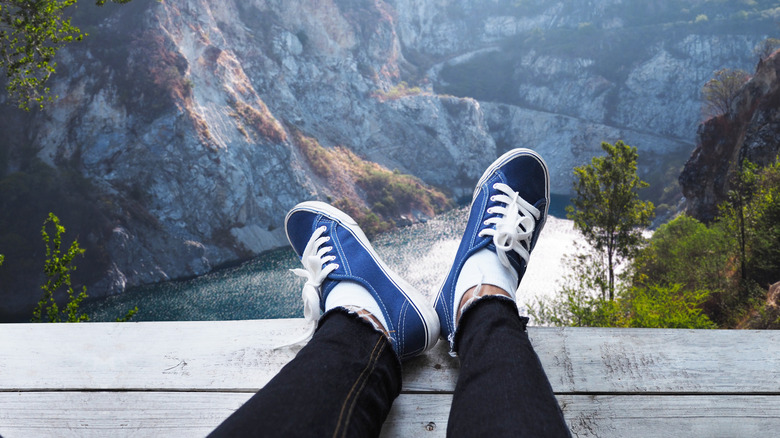
Kanchana P/Shutterstock
Your Vans and Converse may be cozy for everyday wear, but they fall short when it comes to supporting you for an outdoor venture. First, the canvas material provides very little protection against rough terrains as it can easily rip on sharp rocks or branches.
Canvas shoes also have stiff soles and no ankle support, which can lead to discomfort and even blisters, especially during long walks or hikes on rocky trails. The material is also not waterproof and takes too long to dry.
New shoes
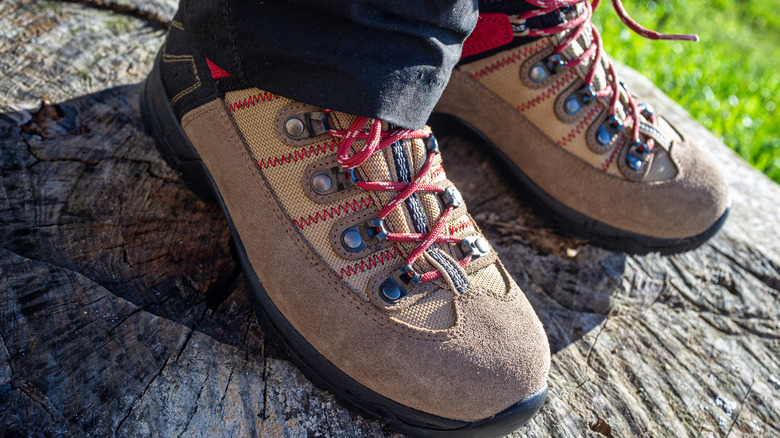
Giocalde/Getty Images
Brand-new shoes might seem like the perfect choice for a national park adventure, looking all shiny, sturdy, and ready to go. However, hiking or walking long distances in new shoes that haven’t been broken in can lead to discomfort and blisters. So make sure to break them in gradually before your trip — walk around the house or take short walks to help soften the materials and mold them to your feet.
Some shoes, such as synthetic boots or trail runners, don’t actually need to be broken in, but it’s still a good idea to take them for a test walk before your trip.
White shoes
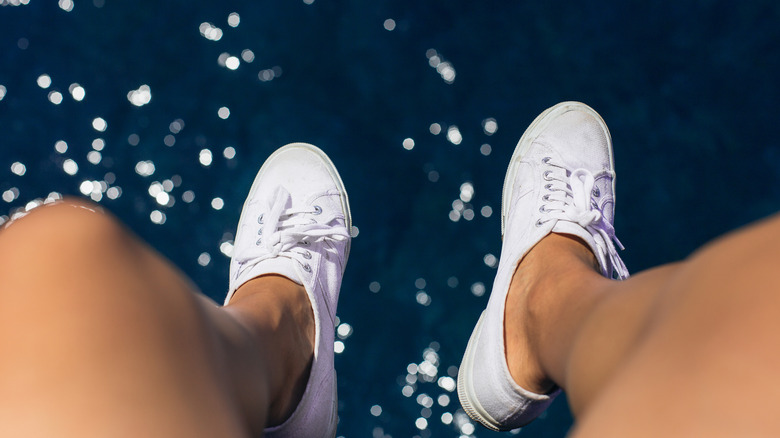
Aaron Guo/Shutterstock
The rugged terrain and dirt paths in national parks can quickly turn your stylish white shoes into a muddy mess. Over time, the constant exposure to dirt, mud, and other elements can take a toll on their appearance, and they may never look the same again. Plus, white shoes are generally harder to clean even after your trip.
Opting for darker-colored footwear can provide peace of mind, allowing you to enjoy the trip without worrying about keeping your shoes clean and pristine. Darker shoes are not only more forgiving of stains and dirt but also offer greater versatility, effortlessly complementing a variety of outfits.
Open-toed sandals
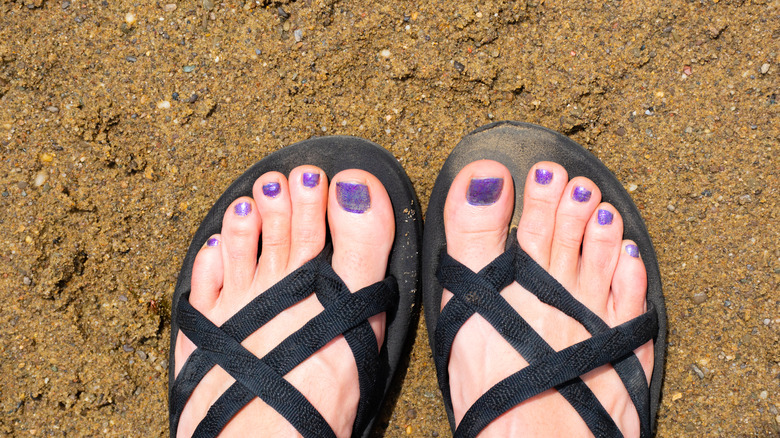
RacheeLynn/Shutterstock
Open-toed sandals offer minimal protection for your feet, making them vulnerable to insect bites, sunburn, cold weather, and scrapes. The lack of coverage also means your feet are exposed to dirt, rocks, and mud, which can make your walk or hike uncomfortable and may cause injuries. They also lack the support and stability required for navigating uneven or slippery trails.
The sandal straps can also cause hotspots after a long time of walking in unsteady environments. For a safer and more comfortable hiking experience, opt for closed-toe shoes with sturdy soles and good traction, such as hiking boots or trail shoes.
Low-quality socks
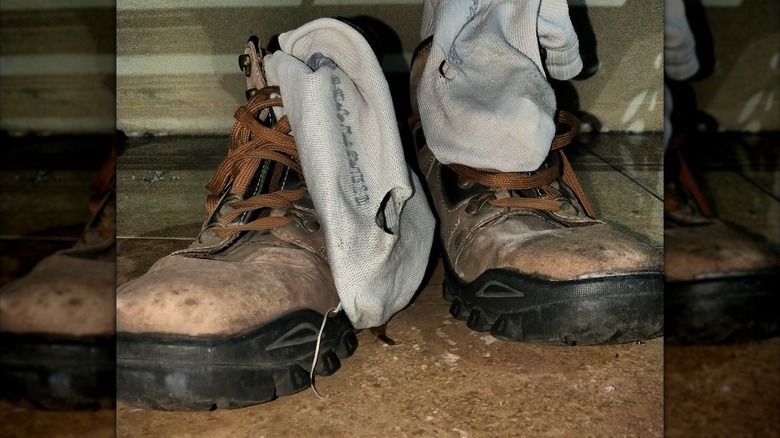
Gocky Sitompul/Shutterstock
This small detail can make or break your adventure. Low-quality socks are often made from inferior materials that can cause discomfort during long walks or hikes. Avoid socks with inadequate padding, as they offer little protection against friction and can lead to blisters and sore spots. Some hikers even recommend wearing two layers of socks to make sure their feet are comfortable, and their hiking boots fit really well.
Aside from that, you should not wear socks that are not loose-fitting to ensure proper compression. Socks made from cotton should also be avoided, as they tend to hold moisture, leading to sweaty and uncomfortable feet. Instead, choose the ones made from wool or synthetic blends.
Bright colors

Kristinakibler/Getty Images
Brightly-colored clothing might be fun to wear, but it’s not the best choice for national park adventures, especially when there’s a chance for exciting encounters with wildlife. Some animals are attracted to bright colors and might approach you, putting you at risk of a dangerous encounter.
To prevent this, many national parks recommend wearing muted, neutral colors or even camouflage prints. These colors help you blend in better with your surroundings, making you less visible and disturbing to wildlife, free to roam around and enjoy them from a safe distance.
Bras with clasps

Falon Koontz/Shutterstock
For a comfortable and enjoyable hike inside and out, choosing the right undergarments is vital. You may be familiar with or even love bras with clasps, but your adventure calls for something more comfortable and practical. Bra clasps can dig into your skin and cause discomfort, especially during long, strenuous activities.
Instead, opt for sports or seamless bras that are specifically designed for support during physical activities. These types of bras are made from moisture-wicking fabrics that help keep you dry and comfortable, even during intense hikes or climbs. Additionally, sports bras offer more flexibility and freedom of movement, allowing you to move comfortably without feeling restricted.
Jewelry

Wundervisuals/Getty Images
Leave your precious rings and bracelets behind when heading to national parks. Wearing jewelry such as rings, bracelets, earrings, or necklaces can increase the risk of injury, especially if caught on branches or rocks. Toe rings, in particular, can cause blisters and discomfort when walking long distances or on rugged terrain.
Furthermore, you wouldn’t want to risk losing your favorite pieces while exploring the park’s trails or attracting unwanted attention, increasing the risk of theft. You can wear practical items like a sports watch, but make sure it’s water-resistant and worn tight around your wrist.
Bikinis

Syda Productions/Shutterstock
Many national parks are home to indigenous cultures, and it’s best to dress appropriately out of respect for their traditions and beliefs. Even when the area offers activities with or near water, like swimming, sunbathing, or picnicking, it’s best to check if wearing a bikini is culturally acceptable before packing one.
To be safe, opt for swimwear with more coverage or water-friendly outdoor attire like board shorts and a moisture-wicking shirt. This not only demonstrates respect for the local culture but also makes sure you are comfortable during various activities around the park, be it swimming or hiking. When exploring a national park, it is wise to cover all the bases.
Fancy handbags
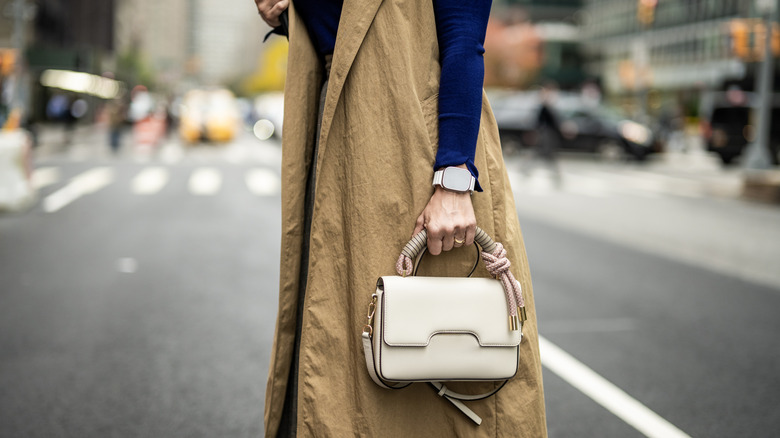
Extreme-photographer/Getty Images
An adventurous day out in national parks is certainly not the time and place to make a fashion statement. That said, leave your fancy bags at home as they are not the most practical choice for your journey. You risk damaging the bag because the delicate material isn’t sturdy enough to handle uneven terrain and rough surfaces.
Handbags are also not the easiest to carry during long hikes or climbs because the weight is not distributed evenly, leading to discomfort and the possibility of being thrown off balance. Instead, opt for a sturdy backpack, and don’t forget a rain cover if your bag is not waterproof.
Backpacks that don’t fit
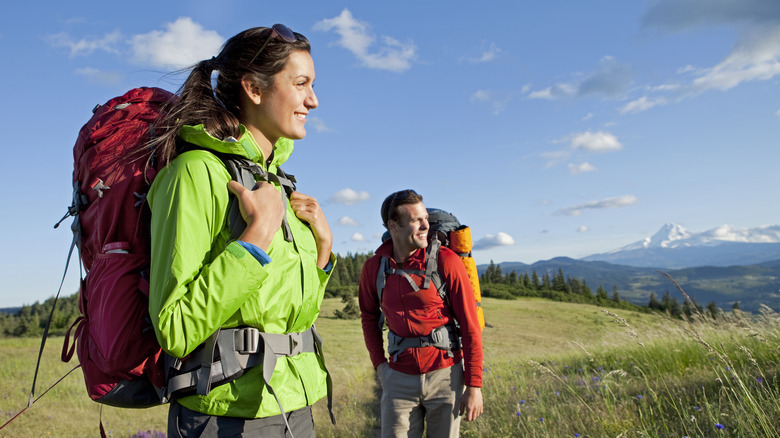
Jordan Siemens/Getty Images
Backpacks are an excellent choice for carrying all your essentials for an outdoor adventure. But using one that doesn’t fit properly can cause strain on your shoulders, back, and hips, especially during long hikes or when carrying heavy loads. Using a backpack that is too big or small for your frame can also affect your balance and stability, making it harder to navigate uneven terrain.
To avoid rubbing and chafing that can lead to blisters or irritation, look for a backpack with adjustable straps. The backpack should sit comfortably on your shoulders and hips, with the weight distributed evenly. Also, make sure you consider the length of the journey, weather, and destination when choosing your backpack.
Clothes with excessive decorations

Aia DS/Shutterstock
Wearing clothes with excessive decoration may make you feel more stylish, but it’s not worth the risk when you’re out and about in national parks. Extra beads, frills, ruffles, bows, decorative zippers, and buttons can easily get caught on branches or rocks, potentially leading to damage or injury. Also, these embellishments can make the clothing heavier, adding a small but unnecessary burden during long hikes or walks.
Instead, wear clothing made from lightweight, breathable fabrics with a practical and functional design. Trust us, wearing comfortable clothing with a good fit will also make you look stylish.
Hats that are not weather-appropriate
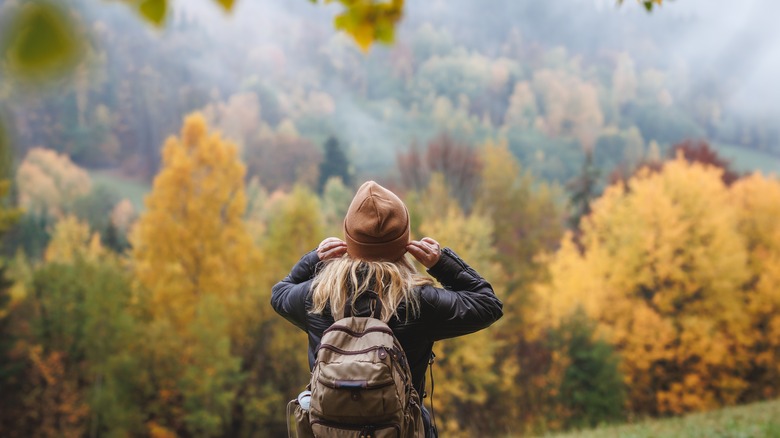
encierro/Shutterstock
When it comes to an outdoor adventure, hats are one of the most essential apparel as they protect you from the weather, insects, and debris in nature. However, it’s equally important to choose a hat suitable for the weather conditions.
For colder weather, you can wear a beanie or insulated hat that provides warmth and protection from the cold. On the other hand, for sunny weather, choose a cap or hat with a wide brim that provides shade and protection from the sun. It’s also important to wear a hat that is made from a breathable material and make sure it fits well so it won’t be easily blown away by the wind.
Non-waterproof watches
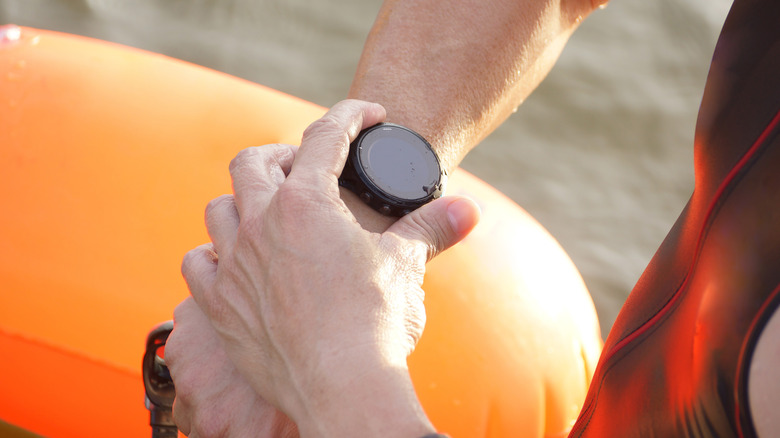
wk1003mike/Shutterstock
National parks often offer opportunities for swimming, boating, or exploring near water, and a standard watch isn’t the best idea. A waterproof watch would be more practical. Even if you don’t plan on getting wet, unexpected rain or splashes can easily damage a non-waterproof watch.
Wear a waterproof or water-resistant watch, or even better, consider wearing a fitness tracker. Fitness watches are often water resistant and offer additional benefits for your adventures, such as tracking your steps, distance, heart rate, and possibly GPS functionality. Just make sure you’re wearing it comfortably, not too tight or too loose on your wrist.
Perfumes
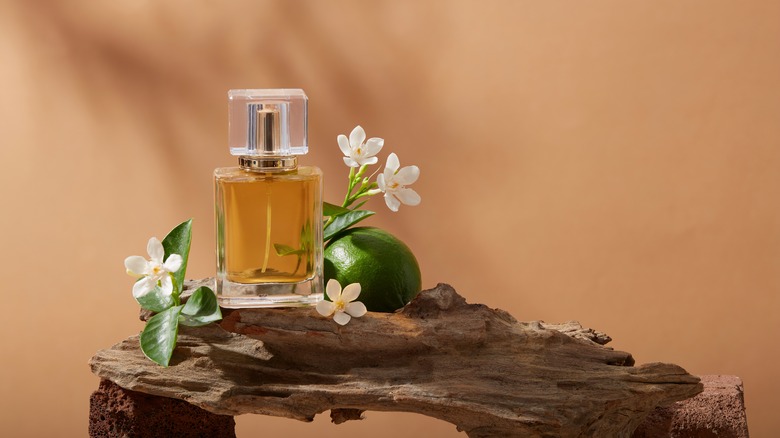
Light Stock/Shutterstock
The strong scent of perfume can be disruptive to wildlife, as animals have a keen sense of smell that can be overwhelmed by overpowering fragrance. Additionally, some perfumes contain chemicals that can harm the environment, especially in delicate ecosystems like national parks.
Floral and fruity fragrances can also attract bugs, which can cause discomfort during your outdoor journey. This caution extends to scented body lotions as well. Instead, just enjoy the fresh air and natural earthy, woody smell of nature.
Spray-on sunscreens
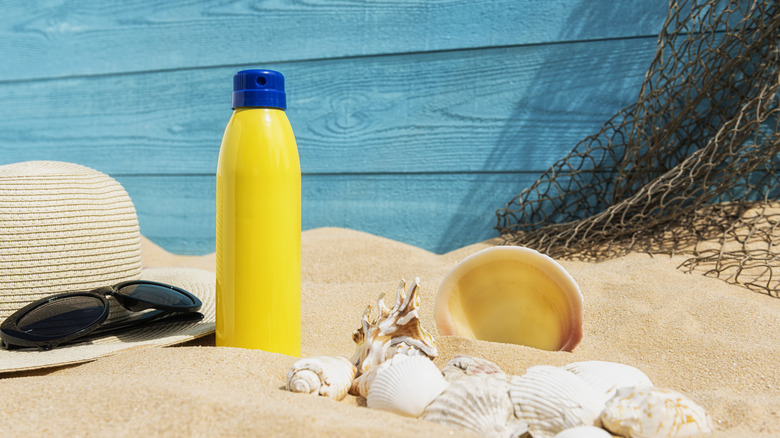
Cmannphoto/Getty Images
When visiting national parks, sunscreen is a must for proper sun protection, but make sure you pick the safest kind. Spray-on sunscreen seems convenient as it’s easy to re-apply anytime during hikes, but it can be harmful to the environment. When sprayed, some chemical particles linger in the air and settle on surfaces, disturbing the pristine natural environment.
The aerosol cans are also often flammable, which can be a danger during hot weather conditions. Instead, wear lotion-based sunscreen that can be applied directly to the skin to minimize impact on the environment. If you plan on going into the waters, make sure your sunscreen is labeled reef-safe to protect the marine ecosystems.
Not enough layers
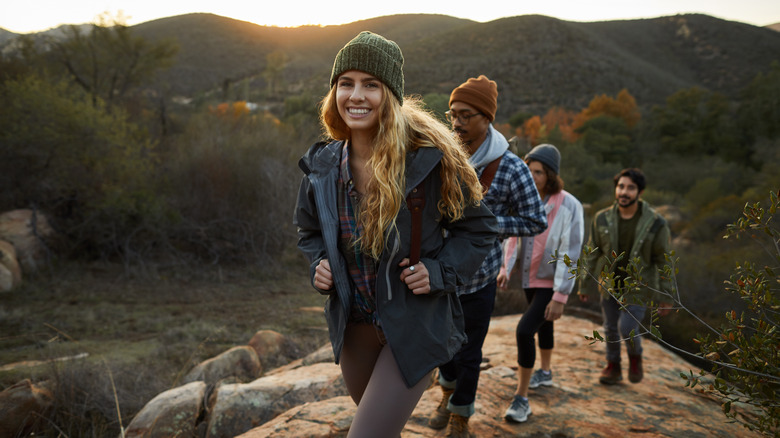
Goodboy Picture Company/Getty Images
Staying warm and dry is crucial for comfortable and enjoyable outdoor explorations. However, your needs can vary depending on the weather, elevation, and time of day. That’s why it’s important to prepare enough layers when visiting a national park, regardless of how the weather looks at the start of your hike.
A best practice is to have three layers. Start with a breathable base layer to wick sweat away from your skin, add insulating layers for warmth, such as a fleece or down jacket, and finish with a waterproof and windproof outer layer to protect you from the elements. This way, you are prepared for anything and can easily adjust by adding or removing layers as necessary.

